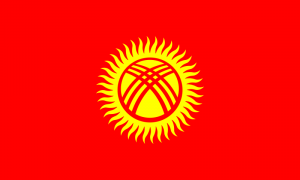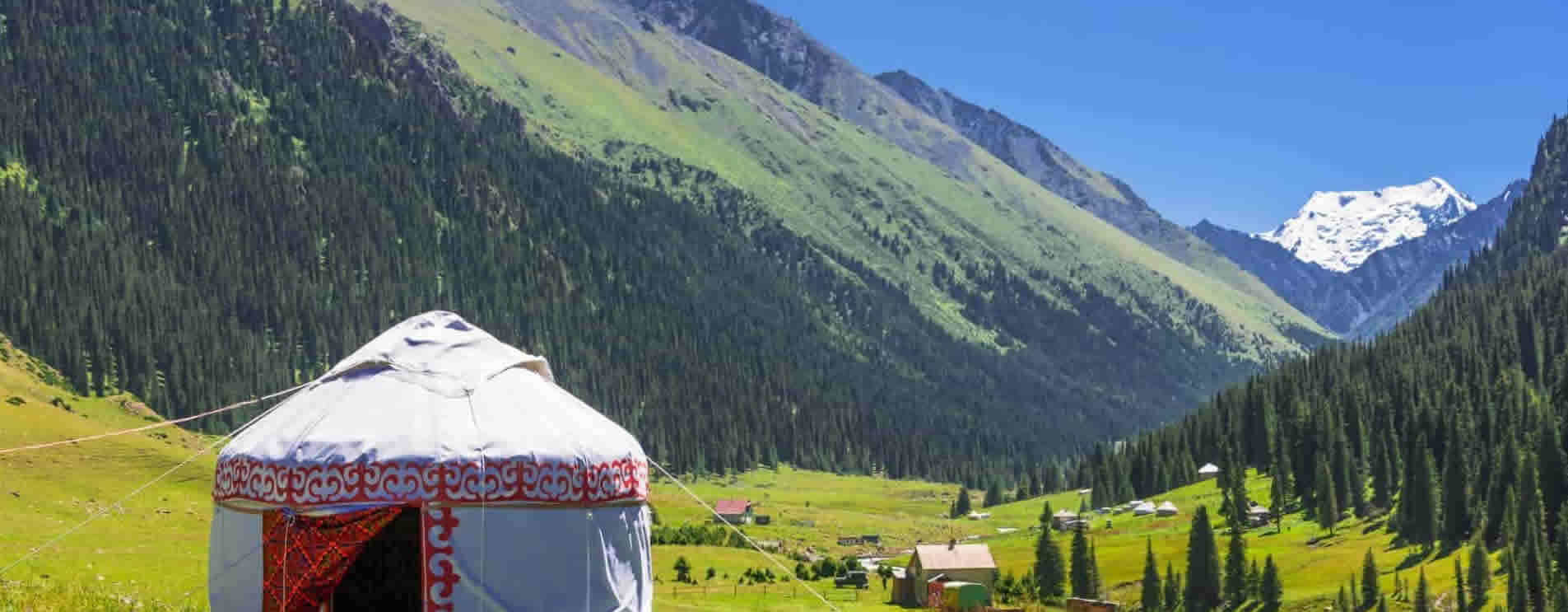Language/Kirghiz/Culture/Kyrgyzstan-Timeline
History of Kyrgyzstan[edit | edit source]
FROM THE ORIGINS UNTIL INTEGRATION INTO THE TSARIST EMPIRE[edit | edit source]
The Kirghiz are the oldest known Turkish people in historical records. Mentioned as early as the 7th century in the upper reaches of the Yenisei, the Kyrgyz transhumant herders appeared in the Tian Shan massif from the 16th century onwards and were subjected to the great Kazakh horde then, from 1820 to 1864, to the khanate of Kokand. It was at this time that they converted to Islam. Following the annexation of the Khanate to the Tsarist Empire in 1876, political and social revolts broke out between the Kyrgyz and the new colonial administration, prompting many clans to emigrate to China.
THE SOVIET PERIOD (1917-1991)[edit | edit source]
The Russian Revolution of 1917 led to the creation of an Autonomous Soviet Socialist Republic (RSSA) of Turkestan, the northern part of which was reorganized in 1920 into a Kyrgyz RSSA covering present-day Kazakhstan (the Kyrgyz were then referred to as the Kara-Kirghiz). In 1926, the Kyrgyz RSSA was again divided into an RSSA of Kazakhstan to the north and an RSSA of Kyrgyzstan to the south, with the capital Frunze (now Bishkek) both federated with Russia, and which in 1936 became constituent republics of the USSR The Soviet power began in 1928 a policy of sedentarization and forced collectivization of the Kirghiz, still largely nomadic. The government then appears to be one of the most loyal among the federated republics, especially since the local elite only accedes to the orders of the Republic under Leonid Brezhnev. The end of the Soviet period was marked by ethnic tensions in the south of the country, in particular in the cities of Osh and Uzgen between the Kyrgyz and the Uzbek minority of Kyrgyzstan in June 1990 (171 dead).
INDEPENDENT KIRGHIZISTAN[edit | edit source]
AKAIEV ERA[edit | edit source]
It is in this tragic context that Kyrgyzstan gains independence. The first secretary of the Kyrgyz Communist Party having to resign at the end of the conflict, academician Askar Akaïev becomes the head of the party. He was elected President of the Republic in October 1991, then re-elected in 1995 and 2000. A new Constitution was adopted in May 1993. Wishing to transform his small mountain country into "Switzerland of Central Asia", Akayev adopted, as soon as he was elected. came to power, a democratic and liberal attitude and undertakes a daring policy of privatization, thus seeking to attract foreign investors. In domestic politics, it has to face several threats: the exodus of the Russian-speaking community, a quarter of the population, causes a brain drain and administrative skills. To stem this phenomenon, the government is trying to reassure minorities by launching the “Kyrgyzstan, our home” program with the aim of building a civic identity transcending ethnic divisions and by raising Russian to the rank of co-official language. Religious radicalization in the Muslim sphere with the development of Islamist networks, but also in the Christian sphere with the establishment of evangelical churches, is forcing the authorities to toughen their religious legislation.
In foreign matters, the Akayev era was marked by a multi-sectoral policy: maintaining privileged links with Russia, which has had a military base in Kent since 1991; establishment of new relations with China, linked to Central Asia by the Sino-Kyrgyz passes of Torougart and Irkechtam; support for the allied coalition in Afghanistan with the rental of the Manas military base (Bishkek airport) to the US army.
THE "TULIPS REVOLUTION"[edit | edit source]
The legislative elections of March 2005 are a stake for the opposition which aims, failing a victory, the control of at least a third of the national parliament. The opposition is seeking to prevent Akayev from revising the Constitution in order to be able to run for a new term. The results give 92% of the seats to the presidential party and only 6 out of 75 seats to the opposition, which immediately denounces fraud. Motivated by the success of the Georgian and Ukrainian revolutions, the opposition parties, gathered around charismatic leaders from the South (Kourmanbek Bakiev) and the North (Feliks Kulov, Roza Otunbaïeva), lay siege to the capital and succeed in overthrowing the March 24, 2005, Askar Akayev, who takes refuge in Russia. An interim government of national unity is formed around the three leaders. K. Bakiev was elected President of the Republic in July 2005. He appointed F. Koulov Prime Minister.
THE AUTHORITY AND NEPOTIC DRIFT OF KOURMANBEK BAKIEV (2005-2010)[edit | edit source]
Post-revolutionary euphoria quickly gave way to political instability and the growth of crime. F. Koulov resigned in 2006 to denounce a constitutional revision which strengthened the powers of the president. K. Bakiev quickly disappoints all hopes of change by installing his relatives in key positions (intelligence, diplomacy), especially in the sectors of the economy - energy and telecommunications - where privatizations are being played out. The pro-presidential party Ak Jol won nearly 80% of the votes in the legislative elections of December 2007. Since then, the opposition has continued to demand the resignation of K. Bakiev and the return to a balance of executive and legislative powers. Despite the absence of real reforms, the president is playing on his country's strategic position and the antagonisms between Russians and Americans, who have military installations there, to make themselves indispensable. After threatening to close the American military base at Manas, an essential logistical support point for NATO operations in Afghanistan, he finally decided, in July 2009, to renew, upwards, the American lease, while authorizing the Russia to open a second base, as part of the Collective Security Treaty Organization.
His re-election on July 23, 2009, with 76% of the vote, far ahead of the main opposition candidate, Almazbek Atambayev (8% of the vote), led to clashes between the police and a group of about fifty opponents who denounces fraud. The Organization for Co-operation and Security in Europe (OSCE) deplores numerous irregularities.
THE OPPOSITION TAKES OVER THE POWER (APRIL 2010)[edit | edit source]
On April 7, 2010, President Kurmanbek Bakiev was overthrown. The unrest, triggered by a sharp rise in electricity and heating prices, began at the start of the year. Social and economic in nature, the demands, supported by the opposition, quickly took a political turn and animated several demonstrations on the occasion of the commemoration of the "revolution of the tulips". On April 6, the demonstrators took control of the regional administration building in Talas, in the north of the country, before being violently repressed by the police. On April 7, in Bishkek, they took over the Parliament, the Presidency, the Ministry of Justice and state television in a few hours, resulting in the fall of the government and of President Bakiev, who fled and ended up finding asylum in Belarus where he refuses to resign. The violence is said to have left 75 dead and more than a thousand injured.
A provisional government, made up of 14 members of the opposition and led by Roza Otounbaïeva, ex-Minister of Foreign Affairs and muse of the "tulip revolution", takes the reins of power pending new pluralist and transparent elections.
But his authority over the country remains precarious and, above all, the fall of the regime shakes the fragile territorial, ethnic and religious balance of the country between the majority Kyrgyz population - whose elites are however largely Russified - and the two largest national minorities. , Russian on the one hand in the North (in the province of Tchouï which shelters the capital Bishkek in particular) Uzbek on the other hand, present especially in the South. To the particularly tense relations between Kirghiz and Uzbeks in certain southern provinces (Djalal-Abad, Osh, Batken) is superimposed the economic and political opposition between the more industrialized and Europeanized North and the rural South, more conservative and more Islamized, especially within of the Uzbek minority.
Thus in May, faced with a resumption of ethnic unrest and the risk of conflagration, the provisional government established a state of emergency in the region of Djalal-Abad, stronghold of the deposed president, in the south of the country. country. Instability persists and, from June 10 to 15, the country falls into interethnic conflict: supported by armored vehicles, the Khirghiz surrender, in Osh (in the Fergana valley, a multi-ethnic region where the Uzbeks represent 40% of the population local) and in Djalal-Abad, to anti-Uzbek pogroms, killing thousands and injuring hundreds and pushing some 400,000 people towards Uzbekistan.
THE ESTABLISHMENT OF A PARLIAMENTARY REGIME[edit | edit source]
Despite the persistence of tensions in the south of the country, the first parliamentary system in Central Asia was established after approval by referendum on June 27. Although elected for 6 years by unive suffrage
Sources[edit | edit source]
- https://fr.wikipedia.org/
- https://www.petitfute.com/
- https://www.larousse.fr/encyclopedie/pays/Kirghizistan/127547
World Timelines[edit source]


